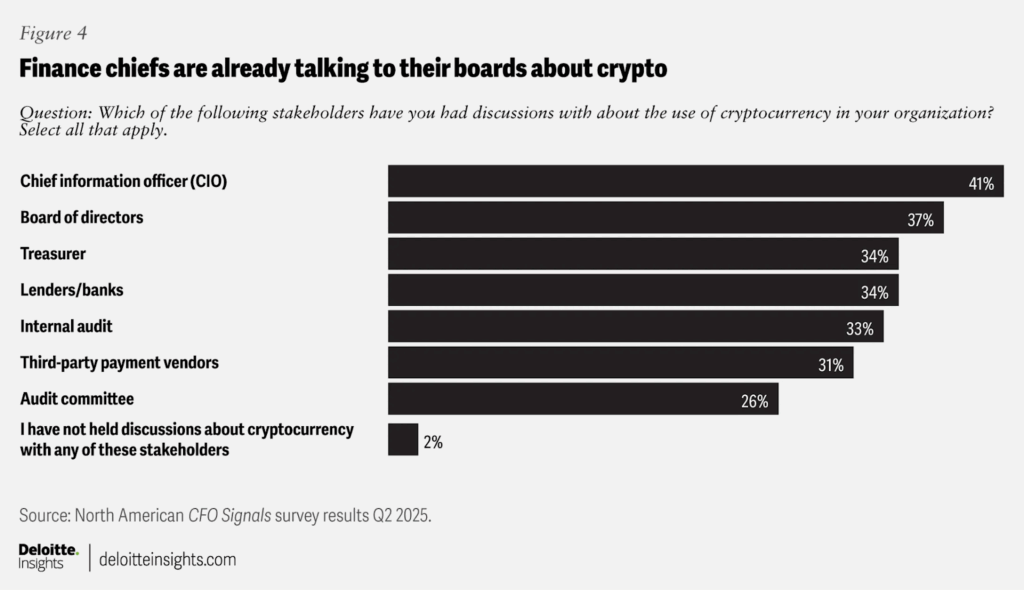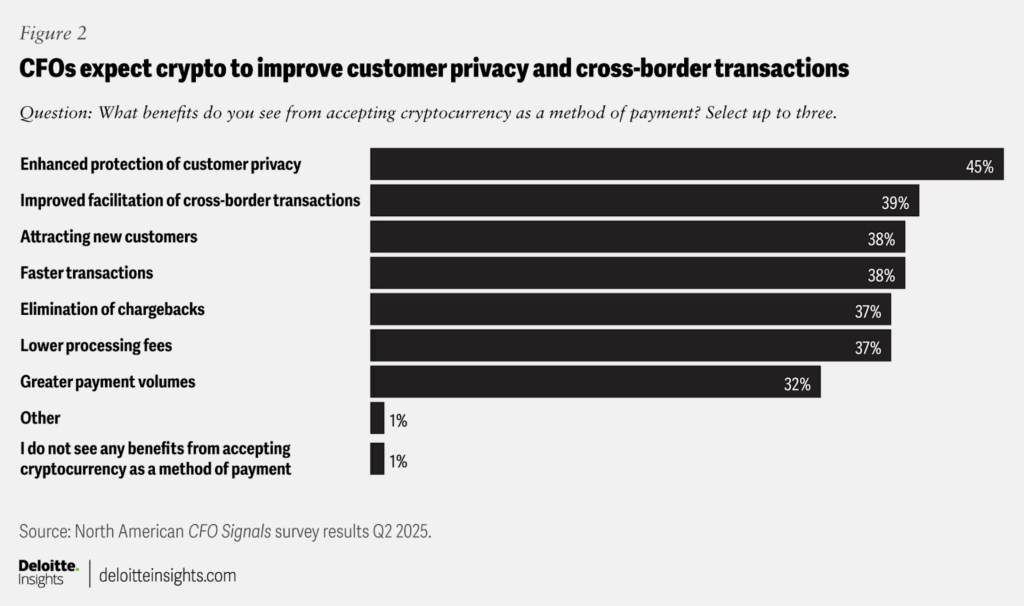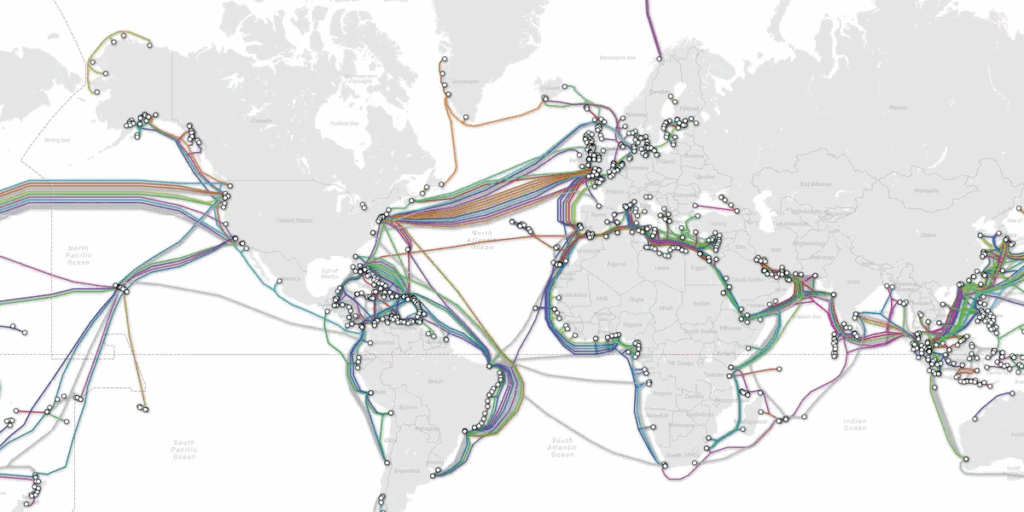The tokenization of conventional finance is again within the information, as fits in boardrooms throughout the US are discussing the advantages and dangers of integrating cryptocurrency into their enterprise. The time period “tokenization” refers to deploying conventional monetary property on cryptocurrency rails, digitizing analog monetary property (together with foreign money), and thus allow the monetary business to learn from the velocity and transparency that blockchains present. However is that this one other crypto fad, or is there a basic drawback that the younger business is addressing for the legacy monetary world?
A Deloitte survey revealed in July polled 200 Chief Monetary Officers working at firms with at the very least US$1 billion in revenues on the subject of tokenization. The survey confirmed that the majority CFOs count on their enterprise to make use of “cryptocurrencies for enterprise capabilities in the long run.” Just one% of these polled stated they didn’t envision it. And 23% stated their treasury departments “will make the most of crypto for both investments or funds throughout the subsequent two years,” a proportion which is nearer to 40% for CFOs at organizations with US$10 billion in revenues or extra. Additionally, of these surveyed, solely “2% of respondents stated they haven’t had any conversations about cryptocurrency with key stakeholders”.

Tim Davis, a Principal at Deloitte informed Bitcoin Journal that there are two narratives making their method by means of American finance, “one is whether or not to have Bitcoin on the stability sheet and the opposite is a broader appreciation of tokenization’s future, which appears more and more inevitable.” He added that “step one is commonly stablecoins—how you can undertake them, whether or not to challenge their very own coin. Extra corporates are having this broader technique dialog as we speak than these committing to Bitcoin on the stability sheet.”
Stablecoins specifically have captured Wall Street and Washington’s interest, as a instrument that may serve the pursuits of the US each at residence and overseas. The survey bolstered this rising pattern, exhibiting that fifteen % of CFOs count on their organizations to just accept stablecoins as fee throughout the subsequent two years, a proportion that’s “greater (24%) for organizations with at the very least US$10 billion in income.”
When requested about the advantages of “accepting cryptocurrency as a technique of fee”, CFOs cited enhanced buyer privateness as probably the most invaluable _____, recognizing the huge harm done to user privacy by legacy know-your-customer (KYC) model knowledge assortment legal guidelines, and their unintended consequences in the digital age.

Davis says the monetary business can be monitoring coverage actions like “the SEC’s Undertaking Crypto and related efforts by the CFTC which can be mapping out market construction.” He additionally talked about the CLARITY Act, which “handed by the Home and is underneath Senate consideration, bolstered by regulators as defining vital buildings” and which goals to offer regulatory readability for crypto-related companies, together with tokenization-related operations. In keeping with Davis, firms see this infrastructure transition as inevitable. “It’s doubtless a 12 months out — and persons are fascinated by what it means for his or her enterprise,” stated Davis.
Davis added that “pre-COVID, blockchain was thought of useless, however we’re rising from that disillusionment. Capabilities have improved, the regulatory surroundings is best, and corporates see friends discussing this. Board members, usually CEOs or CFOs from different firms, convey these strategic discussions again to their groups, spreading the inevitability of it, and the strategic decisions wanted.”
Step-by-step, the Bitcoin and crypto business is merging with conventional finance, and the implications are extra profound than most individuals suppose. Phrases like “tokenization” and “actual world property” or RWAs are sometimes stated in the identical breath, virtually handled as synonyms. However what does “tokenization” actually imply for Wall Road and CFOs throughout America, and why are they so intrigued by it?
Davis says stablecoins and real-world asset tokenization usually are not about being stylish, reaching youthful prospects, or increasing into overseas markets, however they’re about upgrading basic layers of the monetary infrastructure, with new qualities like greater velocity of cash, extra privateness for customers, whereas additionally growing transparency and real-time knowledge about transactions throughout the market.
Satoshi Nakamoto on the Issues with Conventional Finance
The curiosity proven by CFOs relating to the “tokenization” of finance is a subject Bitcoiners could be underappreciating and misunderstanding. In reality, the issues that conventional finance (TradFi) appears to be like to resolve with ‘tokenization’, may not be too removed from these Satoshi Nakamoto recognized and sought to handle in his unique Bitcoin white paper — the technical doc that gave delivery to Bitcoin and the fashionable cryptocurrency business.
”Commerce on the Web has come to rely virtually completely on monetary establishments serving as trusted third events to course of digital funds. Whereas the system works effectively sufficient for many transactions, it nonetheless suffers from the inherent weaknesses of the trust-based mannequin,” Satoshi Nakamoto wrote in late 2008 in his seminal work.
This quote strikes on the coronary heart of the matter. The know-how that underpins TradFi was thought out earlier than the invention of the web. Earlier than computer systems orders of magnitude extra highly effective than the Apollo II have been within the pockets of over half of the world’s inhabitants, earlier than web fiber strains thick as whales have been rolled out throughout the ocean sea beds to attach the world, earlier than decrease orbit satellites adorned the evening sky, raining data right down to residence antennas and again, as if a brand new constellation had entered the pantheon, born of man’s envy of the Gods.
Earlier than all that, the brick-and-mortar, high-trust, worldwide banking membership made sense. However within the daybreak of the digital age, loads of the previous methods of doing enterprise can profit from a shift; Bitcoin invitations them to evolve.

So, maybe Wall Road’s curiosity in tokenization isn’t only a fad. Davis defined that “it’s not about onboarding youthful generations or increasing outdoors of the U.S., it’s about remodeling how enterprise is completed as we speak utilizing tokenized blockchain rails, and there’s growing appreciation for the way current rails may be improved.”
The upside to upgrading monetary infrastructure “is large,” Davis added. “Brief-term implications embrace elevated velocity of cash. Sooner commerce settlement and international cash motion. It frees up capital held in inefficient methods.”
Blockchains have already reworked buying and selling schedules all through the world, as they operate 24/7, which isn’t the case in TradFi, Davis famous.
As a selected instance, Davis defined that the best way the worldwide motion of cash works as we speak.
“In the event you’re a financial institution, you mainly must pre-fund these fee channels,” he defined.
“Let’s say you’re anticipating about $100 million of motion in a day in a sure channel, it’s a must to fund that to the extent of 120% simply in case. So, you’ve received over time $20 million of useless cash that’s sitting there, however doesn’t want to sit down there. It’s not solely growing the velocity, you’re additionally releasing up cash that’s in any other case trapped in an archaic system”.
Diving deeper into how trades get settled in tradFi as we speak, Davis defined that “the SEC has lengthy had this program in place to speed up the timeline by means of which securities trades get settled.”
“At this time we’re engaged on a T+1 mandate, including a day of delay to settle a commerce. However more and more — and it’s actually been with the shift within the administration within the White Home — there’s this realization that we do should be wanting extra significantly at blockchain rails, if we’re ever going to get to this T+0, which is the settlement of transactions throughout the similar day, ideally in hours, if not minutes,” he added.
On the coverage entrance, Davis highlighted that “there’s a very concerted shift happening from regulators, these monetary intermediaries that work on these sorts of settlements in addition to all of the arms of presidency to push the best way that our monetary markets work, to comprehend the advantages of this new know-how.” The advantages to the financial system as an entire can be important, Davis informed Bitcoin Journal that underneath this new paradigm it “turns into dramatically extra environment friendly for firms and people to handle their cash and their positions — be it shares, bonds, or actual property.” It could enable folks to make necessary monetary choices “with no need loads of these archaic methods that add value and in some circumstances even add danger,” Davis added.
Why Satoshi Nakamoto Selected Proof of Work
There’s one principal drawback with the blockchain and tokenization coming from Wall Road, and that’s that almost all blockchains are merely not safe on the consensus stage. In an effort to obtain excessive ranges of transaction velocity and throughput, many cryptocurrency initiatives put the CPU and reminiscence burdens of operating blockchain infrastructure on skilled ‘node runners’ elevating the prices infrastructure dramatically. That is in distinction to Bitcoin’s layered method, which retains layer one small and simple for anybody to run a duplicate of, whereas settling excessive velocity funds on the Lightning Community.
In an effort to skip the sluggish and dangerous build-up of a proof of labor mining neighborhood, many cryptocurrency initiatives launch these networks as proof of stake protocols as a substitute, which has coin holders vote on consensus choices with their stability, as a substitute of mining. These votes symbolize energy on the community, and may determine issues reminiscent of which transactions make it into the blockchain, and even reverse transactions altogether. The result’s but once more a trusted system that, whereas presumably extra environment friendly and fraud-proof than TradFi, however begins centralized and will keep that method, making it doubtlessly susceptible to litigation.
Satoshi Nakamoto understood the added prices and systemic dangers of trust-based settlement methods deeply, which is why he selected proof of labor as Bitcoin’s consensus protocol. “Utterly non-reversible transactions usually are not actually attainable, since monetary establishments can not keep away from mediating disputes. The price of mediation will increase transaction prices — with the potential of reversal, the necessity for belief spreads,” he wrote within the first paragraph of the Bitcoin white paper.
“Retailers have to be cautious of their prospects, hassling them for extra data than they might in any other case want. A sure proportion of fraud is accepted as unavoidable. These prices and fee uncertainties may be prevented in individual through the use of bodily foreign money, however no mechanism exists to make funds over a communications channel and not using a trusted social gathering,” he added.
Whereas Wall Road will doubtless ignore Bitcoin because the superior blockchain on high of which to construct out its tokenization and settlement plans, if the consensus layer issues in any respect, they may finally study the arduous method, by means of litigation and disputes, that having finality — or as bitcoiners name it, immutability — has its advantages. Those that begin constructing on Bitcoin now will most likely have an edge.
